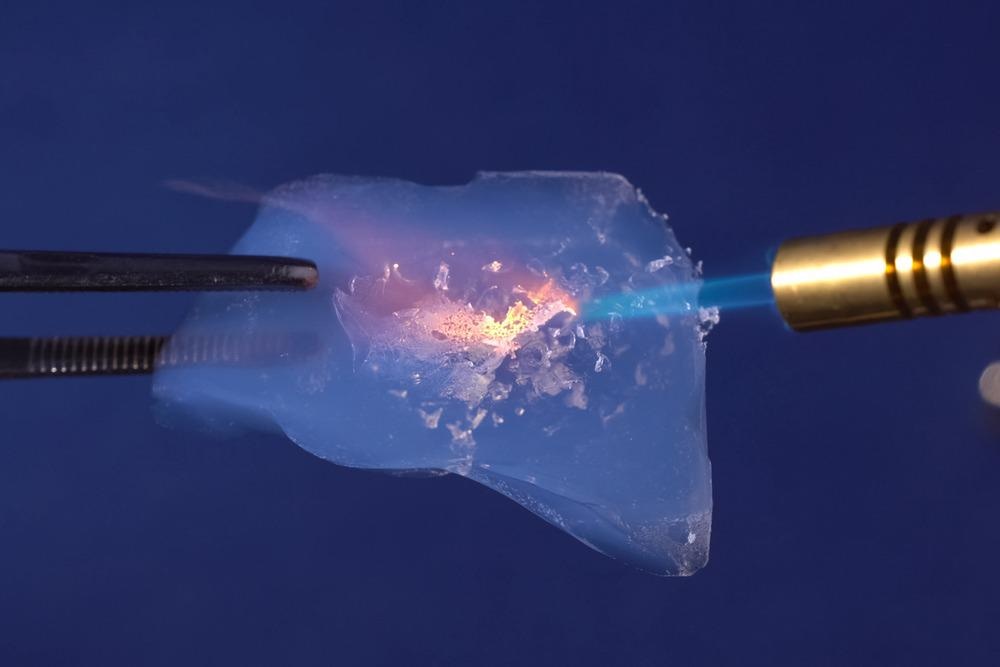Recently, a team of researchers has developed extraordinarily high-strength silica-modified carbon aerogels (SCAs) prepared with facile sol-gel polymerization followed by ambient pressure drying and carbonization. The research was published in the Journal of Colloid and Interface Science.

Study: Ultrahigh-strength Carbon Aerogels for High Temperature Thermal Insulation. Image Credit: LuYago/Shutterstock.com
Aerogels are one of the most effective kinds of insulation available in the solar system. Exceptionally lightweight, porous, and low-density, aerogels can be found as thermal insulation in everyday commercial products to application in NASA space vehicles and probes for missions to Mars and the wider reaches of the solar system.
However, under practical application at high and varying temperatures, aerogels can become susceptible to inherent brittleness and easy-oxidization making them prone to failure.
A team in China believes that the SCAs they have developed demonstrate great promise in extreme-temperature insulation scenarios especially when subjected to harsh conditions: “these superior carbon aerogels will be promising materials for highly efficient thermal insulations at high temperature,” states lead author Professor Donghui Long of Shanghai Key Laboratory of Multiphase Materials Chemical Engineering, East China University of Science and Technology, China.
Carbon Aerogels
Traditional silica-based aerogels have been applied in various applications, such as providing insulation on a Mars Rover, as well as finding use in numerous commercial products where they are typically fabricated in pellet form or in a composite with other materials.
Aerogels possess exceptional and effective insulation properties because they are extremely porous and the pores are in the nanometer range. The nanopores remain invisible to the human eye but it is the existence of these pores that make the aerogel so good at insulating.
Silica-based aerogels are immensely light, as they are around 95% porous, and as a result, they are very useful, but they do have limitations – including fragility. Thus, devising suitable methods to reinforce aerogels would not only boost the material properties but also advance the application potential of aerogels.
Additionally, SCAs that get around the issue of thermal oxidation could help achieve the real application of aerogels at high temperatures, however, an effective method for doing so has remained somewhat elusive.
Innovating Aerogels
Yet, the researchers at East China University of Science and Technology were able to make some progress.
We developed a facile approach to fabricate silica-modified carbon aerogels (SCAs) with high mechanical strength, improved oxidation resistance, and satisfied high-temperature thermal insulation property
Professor Donghui Long of Shanghai Key Laboratory of Multiphase Materials Chemical Engineering, East China University of Science and Technology
While the team prepared the SCAs using sol-gel polymerization it was subsequent the ambient pressure drying and carbonization process that boosted the aerogel’s oxidation resistance: “During carbonization process, the amorphous SiO2 particles gradually transform to 5 crystalline SiC particles by a carbothermal reduction reaction, which will further improve the oxidation resistance of carbon aerogels,” says Long.
Once the researchers had prepared the SCAs they subjected the innovative aerogels to a range of investigations and tests including scanning electron microscopy and exposure to high pressures and temperatures. Using these methods the team was able to characterize the material itself as well as how it performs in various scenarios.
Further Reading - Aerogel: The Lightest Electronics Shield on Earth
The SCAs demonstrated a high compressive strength of 10.0 MPa and met thermal conductivities of 0.118 W·m1 ·K-1 at 25 °C and 0.263 W·m-1·K-1 at 1000 °C. Moreover, needled carbon fiber reinforced SCAs (CF-SCAs) with ultra-high compressive strength of 210.5 MPa was prepared, which demonstrated excellent thermal conductivities of 0.207 W·m-1·K-1 at 25 °C and 0.407 W·m-1·K-1 at 1000 °C.
One of the other key properties the team evaluated was the stability in the air atmosphere, which is a crucial factor when assessing the safety of carbon aerogels. The SCAs exhibited excellent resistance to decomposition when subject to temperatures ranging from room temperature to 520 °C – thereby demonstrating the thermal stability of SCAs.
A Whole New World of Potential
Having successfully produced high-strength silica-modified carbon aerogels prepared with facile sol-gel polymerization followed by an ambient pressure drying and carbonization, the team believes that they have presented an effective aerogel made for use in high-temperature and harsh conditions.
With aerogels already considered to be a must-have material in the insulation industry, an advanced aerogel that can perform its intended function across a vast range of applications, excessive temperatures, and high pressures, could open up a whole new world of potential.
High-strength silica-modified carbon aerogels could be helping advance technology here on Earth as well as assisting space agencies, including NASA, on their voyages across the wider reaches of the solar system.
References
K. Wu, Q. Zhou, J. Cao, Z. Qian, B. Niu, D. Long, Ultrahigh-strength Carbon Aerogels for High-Temperature Thermal Insulation, Journal of Colloid and Interface Science (2021), doi: https://www.sciencedirect.com/science/article/pii/S0021979721019743
Woods, Tori. ‘Aerogels: Thinner, Lighter, Stronger’. 2017 [https://www.nasa.gov/topics/technology/features/aerogels.html accessed November 2021]
Disclaimer: The views expressed here are those of the author expressed in their private capacity and do not necessarily represent the views of AZoM.com Limited T/A AZoNetwork the owner and operator of this website. This disclaimer forms part of the Terms and conditions of use of this website.